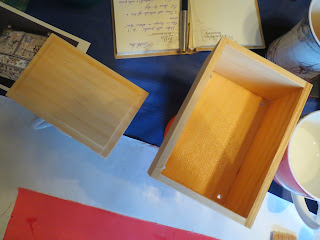Case History
Amy Mitten first came to my attention when she entered, and won,
A Mirror to my Art in 2012. Her entry,
The Mermaid Mirror, seemed innocent enough but my instinct told me that this was someone worth keeping an eye. Over the next couple of years Ms Mitten's name came up from time to time and it was becoming apparent that more and more women were falling under her influence. I began to collect together evidence of Ms Mitten’s activities which can, and will, be used later. These '
Keepsakes' seemed as innocent and harmless as the
Mermaid Needlework Treasures but further investigation of Ms Mitten's business,
Fibres to Dye For, revealed a shady side to her nature. To find out more, I had to find a way to meet the mysterious Ms Mitten.
© Carol-Anne Conway
For several years I have been closely monitoring a similar organisation,
Thistle Threads. I have been posing as one of the cult's loyal followers who call themselves '
Casketeers'. Over time, I have earned the trust of other
Casketeers and now have infiltrated their secret network on NING where I am able to monitor their communications. It was through this network that I discovered Ms Mitten was widening her net and ensnaring more unsuspecting victims with her '
Keepsakes'.
Although NING is an effective tool for gathering information, I still needed to get closer to Ms Mitten. I hooked up with a local chapter of
Casketeers, called "
The Sampler Guild". Although not a Sampler myself, my activities on NING have convinced them that my interests are sufficiently aligned with their own to give me an in to their circle. Originally, they agreed to 'casual' meet-ups to satisfy our unquenchable thirst for antique embroideries. Later they invited me to join them at an embroidery workshop and eventually I hit pay dirt when they asked if I would be interested in attending a training camp lead by none other than Amy Mitten, herself.
The event took several months to organise but eventually everything fell into place and last weekend I travelled to a secret location in deepest darkest Oxfordshire for my rendezvous with Ms Mitten. On my journey to the training camp I tried not to let the beautiful English countryside distract me from my mission but little did I know how dark the weekend would turn despite the bright autumn sunshine.
© Carol-Anne Conway
The project for this training camp was called '
Ten'. Was it purely coincidence that training began at 10 am on the tenth day of the tenth month? I noticed several of the ladies began taking notes; pretending to do the same, I made some notes on Ms Mitten.
As the class progressed it became apparent to me just how cleverly Ms Mitten's sting was constructed; the detailing was meticulous. I could tell that 'M' had researched her subject thoroughly and new exactly how to draw her victims in. Later that day I arranged to spend some time alone with 'M' by volunteering to chauffer her to the restaurant and back. By feigning interest in her 'story' I was able to interrogate her about her
modus operandi. After I had returned 'M' to her lodgings I made some notes on what I had learned.
Despite the mysterious death, '
Ten' proved popular and Ms Mitten repeated it several times; each time there was another mysterious death. Now that I was aware of the dangers, I wondered if it was wise for me to return to the training camp the next day but I had a strong desire to get to the bottom of this case. My worst fears were realised later that day when I found myself staring at the body of a woman slumped across a sampler stained blood red! The curse of Amy Mitten had struck again!
Conclusion
Case unsolved!
A great deal more investigating is required and I shall, at a future date, look in depth at all of the clues gathered at the training camp. One thing is becoming evident; although apparently working alone, there are several more women operating similar schemes. The advent of the internet has afforded them the opportunity to ensnare their unsuspecting victims, indeed it seems that the victims themselves are unwittingly drawing in like-minded people. They all warrant serious investigation but my department is seriously under-resourced; I fear it may take more than one life-time to complete my mission. For now, I will continue to gather evidence of their activities and hope that one day I will have more time to dedicate to my investigations.
Disclaimer
All people and events are entirely real; no names have been changed to protect the innocent. The facts have been seriously distorted. Any suggestion that Amy Mitten or her company, Threads to Dye For
, are involved in nefarious activities is a blatant lie made up by the author; they are not the views of any one else. The defamation of Amy’s nature is scandalously libellous. I whole heartedly apologise to Amy for this feable attempt to parody her own, beautifully crafted 'Ten' and can only hope that she can forgive me!




















































